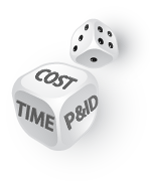
My previous posts on mega-projects bidding and risks highlight a single starting point of success – the cost estimation platform. It dominates in the probability prediction of the project award.
This paper is my attempt to summarize key requirements for such a platform, its primary concern being the equipment component of direct capital costs. (Indirect cost will be discussed elsewhere.)
Historically, advances in the cost estimation techniques (CET) were all along the road of better regression correlations of sparse data samples. Given big sampling errors, these correlations were intended for projects early stage - the plant conceptual design.
Lack of trifles separating concept from implementation and making the design perfection leads to 50% contingency in CET results.
The cost data scarcity and design unsophisticatedness were a good excuse not to go in these correlations beyond 2 – 3 key price-forming parameters (or cost drivers) like capacity, pressure, and material. The same reason is likely the only hurdle on CET way from art to science, from misplaced judgement to rigorous math.
Today we witness 2 dramatic changes in the CET context – abundance of quotes and automation of the plant design. Both produce vast amount of data. Engineering culture is on the rise; not in the distant past EPC contractors in water industry hardly knew what Front End Engineering & Design (FEED) means.
What type of data this platform shall process?
Platform shall target detailed cost estimation following FEED stage where all P&ID items specifications and the plant layout are available.
The platform pricing database shall include vendor & subcontractor quotes, pricing information from previous purchase orders, current labor rates, and project schedule information (to determine escalation requirements).
The first step is to revise the CET scope to match it to the project one.
Platform shall equally address the equipment cost, lead time & indexation.
Lead time (LT) is always the second question after the price. LT is a basis for the project schedule and escalation costs. LT prediction uses the same estimating techniques; even Lang Factors may be applied to LT. Like the price, LT has its internal structure reflecting the manufacturing phases - engineering, materials & components order, manufacturing & assembly, testing, etc.
Conventionally indexation is regarded as a technique for escalating historical costs collected 5 – 20 years earlier. Today, abundance of the costs data, and rapid advances in manufacturing technologies make this task irrelevant and impossible; cost factoring works only within the same chain of technologies.
Indexation of current costs shall make quotes follow the local markets' fluctuations (equipment parts, materials, labor, inflation, taxes, etc.). Indexation is a way to maintain unstained relationships with vendors; it clears any bad feeling about unexpected price rises for recurring purchase orders. For EPC contractors it is a powerful risk mitigation method.
Indexation walks its way into projects through Price Adjustment Clause (PAC). PAC is not part of the purchase orders today. Modern CET does not have an answer how to do this; how to circumvent the assumptions made by costing engineer during the project estimation. PAC cannot be replaced with Bid Validity Clause and the fixed-price quote as mega-projects bidding may last 6 months and more.
Platform shall store the equipment quotes as structured data collected from vendors through standardized web forms.
In fact, such a form mirrors the equipment specification describing the P&ID item.
Current practice stumbles over the bids processing as bidders use their own terminology and the quote format submitted as PDF document. Its interpretation requires human interaction, is error-prone and time-consuming. (An example of the XLS price register template I maintained for many years in the past is given here.)
Digital quotes will reap huge benefits of costs-predictive analytics. The quote structured data is a perfect input for plug-in applications powered by modern statistical algorithms. They turn into routine task building correlation equations and selecting the cost-driving parameters from those listed in digital quote.
Platform shall provide the user interface for managing cost estimating models and their documentation (accuracy, limitations, application range, etc.). These models shall be specification-centric.
The equipment specification describes the P&ID item quantitatively (capacity, pressure, filtration load) and qualitatively (material, standard, grade, configuration, and other attributes). The multiple regression analysis shall cover both characteristics - parameters and attributes.
For example, the cost predicting equation for asynchronous motor may include such parameters as capacity and rotation speed, and attributes like voltage level, ingress protection, and insulation class.
Platform shall automatically select the best-match correlations for any P&ID item and produce cost and lead time values. If this platform will iterate over the whole plant, what will it produce? Plant Cost and … Project Schedule!
Platform shall auto-generate the plant cost and project schedule.
Cost & Schedule may be easily transformed into S-curve describing the project expenditures distribution over the time. Schedule optimization turns into pure math.
By the same token, Platform shall handle the indexation equation for each P&ID item. This equation shall be based on internet-available consumer price indices for materials, labor, equipment, etc. Iteration over the plant will produce PAC to be pasted into the project commercial offer.
The small step of adding LT to P&ID item is a beginning of another big difference. LT is a final missing link in creating the purchase order packages out of P&ID items. I plan to dedicate an article to this critical topic.
Can these requirement be complied with now? Check these videos.
In piping costs prediction Crenger does not use MTO (material take-off) of piping isometrics drawings. They require detailed design not available at the time of the project bidding. All the information is extracted from P&ID and the plant preliminary layout.
